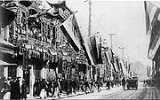
Xinhai Revolution
Overview
Dynasties in Chinese history
The following is a chronology of the dynasties in Chinese history.Chinese history is not as neat as is often described and it was rare for one dynasty to change peacefully into the next. Dynasties were often established before the overthrow of an existing regime, or continued for a time after they...
, the Qing (1644–1912)
Qing Dynasty
The Qing Dynasty was the last dynasty of China, ruling from 1644 to 1912 with a brief, abortive restoration in 1917. It was preceded by the Ming Dynasty and followed by the Republic of China....
, and established the Republic of China
Republic of China (1912–1949)
In 1911, after over two thousand years of imperial rule, a republic was established in China and the monarchy overthrown by a group of revolutionaries. The Qing Dynasty, having just experienced a century of instability, suffered from both internal rebellion and foreign imperialism...
. The revolution was named Xinhai because it occurred in 1911, the year of the Xinhai stem-branch in the sexagenary cycle
Sexagenary cycle
The Chinese sexagenary cycle , also known as the Stems-and-Branches , is a cycle of sixty terms used for recording days or years. It appears, as a means of recording days, in the first Chinese written texts, the Shang dynasty oracle bones from the late second millennium BC. Its use to record years...
of the Chinese calendar
Chinese calendar
The Chinese calendar is a lunisolar calendar, incorporating elements of a lunar calendar with those of a solar calendar. It is not exclusive to China, but followed by many other Asian cultures as well...
.
The revolution consisted of many revolts and uprisings. The turning point is the Wuchang Uprising
Wuchang Uprising
The Wuchang Uprising began with the dissatisfaction of the handling of a railway crisis. The crisis then escalated to an uprising where the revolutionaries went up against Qing government officials. The uprising was then assisted by the New Army in a coup against their own authorities in the city...
on October 10, 1911 that was a result of the mishandling of the Railway Protection Movement
Railway Protection Movement
The Railway Protection Movement , also known as the "Railway Rights Protection Movement", was a political protest movement that erupted in 1911 in late Qing China against the Qing government's plan to nationalize local railway development projects and transfer control to foreign banks...
.

